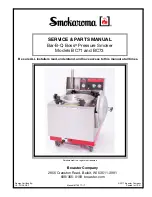
8
The oven offers a wide range of alternatives which allow
you to cook any type of food in the best possible way. The
various features make it possible to select the level of heat
and to direct it as you like: from the bottom, from above or
uniformly. With time you will learn to make the best use of
this versatile cooking appliance and the following direc-
tions are only a guideline which may be varied according
to your own personal experience.
Baking Pastries
When baking pastries, always place them in the oven after
it has been preheated (about 15 minutes). The tempera-
ture is normally around 160°C. Do not open the door while
the pastry is cooking in order to prevent it from dropping.
Batters must not be too runny, as this will result in pro-
longed cooking times. In general:
Pastry is too dry
Increase the temperature by 10°C and reduce the
cooking time.
Pastry dropped
Use less liquid or lower the the temperature by 10°C.
Pastry is too dark on top
Place it on a lower rack, lower the temperature, and
increase the cooking time.
Cooked well on the inside but sticky on the outside
Use less liquid, lower the temperature, and increase the
cooking time.
The pastry sticks to the pan
Grease the pan well and sprinkle it with a dusting of
flour.
I used more than one level and they are not all at
the same cooking point
Use a lower temperature setting. It is not necessary to
remove the food from all the racks at the same time.
Cooking Fish and Meat
Meat must weigh at least 1 Kg in order to prevent it from
drying out. When cooking white meat, fowl and fish, use
low temperature settings (150°C-175°C). For red meat that
should be well done on the outside while tender and juicy
in the inside, it is a good idea to start with a high tempera-
ture setting (200°C-220°C) for a short time, then turn the
oven down afterwards. In general, the larger the roast, the
lower the temperature setting. Place the meat on the cen-
tre of the rack and place the dripping pan beneath it to
catch the fat. Make sure that the rack is inserted so that it
is in the centre of the oven. If you would like to increase
the amount of heat from below, use the low rack heights.
For savoury roasts (especially duck and wild game), dress
the meat with lard or bacon on the top.
Cooking on More Than One Rack
If you have to cook on more than one rack, use only feature
no. 2
“Position of the “G” knob "Ventilated Mode,” as
it is the only one designed for this type of operation.
·
The oven has 5 different rack heights. When cooking with
the ventilated mode, use only the two centre rack heights:
the bottom and topmost rack heights directly receive hot
air and this could result in more delicate dishes being
burned.
·
In general, use levels 2 and 4 from the bottom, placing
the food requiring more heat at level no. 2. For example,
when cooking a roast together with other food, place the
roast at level 2 and the more delicate dishes at level 4.
·
When cooking foods requiring different cooking times and
temperatures, make sure that the temperature is set be-
tween the two recommended temperatures and put the
more delicate dishes at level no. 4. Finally, remove the
dish with the shorter cooking time first.
·
Use the dripping pan at the bottommost rack height and
the grill at the top.
·
When cooking pizza on more than one rack, position the
racks at heights 2 and 4, with the temperature set at 220°C.
Remember to preheat the oven for at least 15 minutes. In
general the 4th rack height cooks a little slower, so re-
move the pizza on the second rack height first and leave
the other one in the oven for a few minutes.
·
When cooking pastries on two racks, use rack heights 3
and 4. Do not use no. 2 because it receives too much
heat.
Using the Grill
The oven allows you to use two different grilling methods.
Use the no. 3 setting
“Grill” for small portions. Energy
consumption for this feature is only 1200 W; however, it is
ideal for grilling small dishes or portions, e.g. toast, frankfurt-
ers, etc.
Place the food in the centre of the grill, as only the centre of
the heating element is turned on. Food in the corners of the
oven will not be cooked.
The no. 4 setting
“Double Grill” allows you to grill along
the entire surface area of the grill itself. Use this feature when
you have food distributed uniformly beneath the grill and you
want it to be browned evenly.
Important: Always leave the oven door closed when us-
ing the grill setting n order to achieve the best results and
save on energy (about 10%).
When using the grill settings, it is recommended that the
thermostat be set to maximum, as this is the optimal setting
for the grill, which utilizes radiation produced by infrared rays.
However, this does not mean that lower temperature set-
tings cannot be used when necessary by simply turning the
control knob.
When using the grill, place the rack at the top rack heights
(see cooking table) and place the dripping-pan beneath the
oven rack to prevent grease from falling onto the bottom of
the oven.
Practical Cooking Advice









































